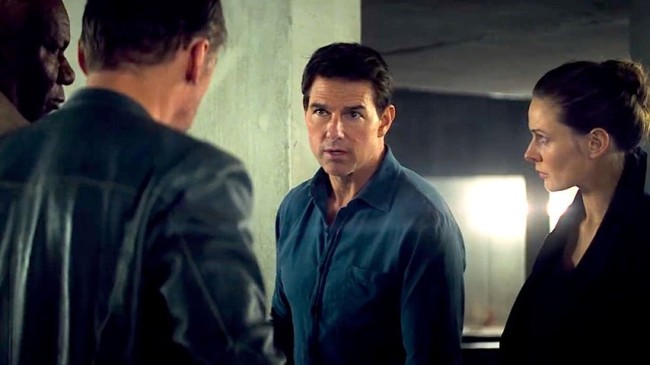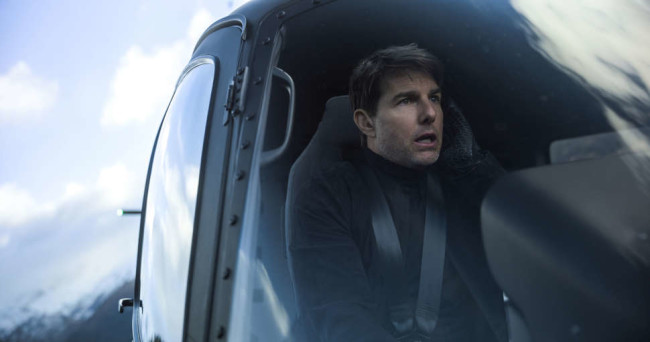Genre: Action
Premise: (from IMDB) Ethan Hunt and his IMF team, along with some familiar allies, race against time after a mission gone wrong.
About: Mission Impossible Fallout is, I believe, the sixth film in the franchise (don’t quote me on that). Christopher McQuarrie, who directed the previous installment, is back in the writer-director chair again. The film scored 61 million at the domestic box office, which is the 9th best opening this year. Not great but Mission Impossible always does well globally and this iteration did especially well with the critics, scoring a 97% on Rotten Tomatoes.
Writer: Christopher McQuarrie (based on the TV series by Bruce Geller)
Details: 150 minutes
Let me start by saying there is no movie I enjoy going to more than a Mission Impossible movie. Why? Because on the way there, you get to hum… “duh duh duhduh duh duh duhduh dadadaaaaaaa dadadaaaaa DUH DUH DUH-DUH DUH DUH DUH-DUH.”
There’s no score you can hum that makes you happier. Try it. I’m serious. Start humming the Mission Impossible theme. Try not to feel happy. It’s impossible, right? Mission impossible!
So everyone’s saying this is the best Mission Impossible ever made. It’s a game-changer. It’s the “Dark Knight” of the series. Before we get into all that, let me tell you what I like about the Mission Impossible franchise. I like Tom Cruise doing his own stunts. I like the silly mask stuff. I like the interplay between the team. I like the gadgety stuff. For example, I like that scene from Mission Impossible 4(?) where they’re sneaking down a hallway with a fake projection empty hallway.
Surprisingly, the thing I like least about Mission Impossible is the action set pieces. I’ll get to why in a second. But first let’s break down the plot. Or at least try to.
Ethan Hunt’s mission, which he chose to accept, is to find three portable nuclear bombs before they can be detonated. He goes to British Lady Gaga to buy the bombs, only to find out that she’s not selling. She’s exchanging. She first needs Ethan to recover a mangy-bearded guy in police custody who I think was the villain from the last movie.
Ethan gets his team together and successfully extracts Mangy Beard, who we find out is working for a mysterious guy named John Lark who nobody’s ever met. Accompanied by new team member, Henry Cavill (Superman), the team prepares to exchange Mangy for the nukes. But the CIA, who think Hunt is a bad guy now for some reason, put an end to this rogue mission, which results in a shootout and Mangy Beard escaping.
It is believed that Mangy Beard, the mysterious John Lark, and these nukes, will be detonated at a remote smallpox lab in Kashmir. The resulting explosion will spread smallpox to the highly populated surrounding countries of China, India, and Pakistan, and basically end the world. Ethan Hunt needs to get there in time to stop it all. But can he???
I don’t know why it’s mission impossible for me connect with these big action spy movies. I really want to. I walk into each one hoping, praying, this will be the day. But it never happens.
Upon reflection, I think I need a STRANGE ATTRACTOR to my popcorn movies. I need Godzilla. I need Jedi. I need a clown that eats children. Straight up realism doesn’t work for me. It feels too basic, too standard. That’s the lens I’m viewing Mission Impossible and James Bond and The Bourne Franchise through. It’s a bunch of run-of-the-mill (albeit well produced) action scenes wrapped inside an overly complicated plot that I can never keep up with.
That’s correct. Yet again, I have no idea what’s going on. And in this iteration, my confusion started early.
We get a scene where Ethan Hunt and his team go to buy the nukes from the bad guys. Before the purchase can be completed, someone starts shooting from the shadows, killing all the bad guys but no one in Ethan’s crew. At the end of the scene, there’s a standoff where one of the shooters is holding Ving Rhames hostage. Ethan kills the man, runs over, and after everyone confirms that Ving Rhames is okay, they look behind them and realize that the nukes are gone.
Wait a minute wait a minute wait a minute. Who stole the nukes? Was it one of the surviving members of the group that brought the nukes? Or was it a third party? If it was a third party, why did they only kill the bad guys? You are literally leaving the most capable person on the planet, the person most likely to be able to track you down and kill you, Ethan Hunt, alive. That makes zero sense.
But the biggest fault of the plotting by far is when the CIA thinks Ethan Hunt is John Lark. I mean come on. Really? This guy who’s been saving the world for the last 20 years, the CIA all of a sudden thinks he’s a bad guy? There’s no way that would happen. It’s such a forced false plot point, it borders on embarrassing.
And then there’s those action set pieces.
Actually, before we get to that, let’s talk about Ethan’s super-power. When, exactly, did Ethan Hunt develop a power that allows him to speed through any intersection at 100 miles an hour and always be able to time it so that he never gets hit by six lanes of cross-traffic?
I get it if this happens once. You look back. “Phew. That was lucky.” But he does it over and over again. The reason this is relevant is because the whole trick with creating great chase scenes is to milk whether the hero will get caught. If your hero has a cheat code where he can zip through six lanes of cross traffic whenever he wants to ditch his pursuers, we know the movie will always save him whenever he gets into any real trouble. There’s zero sense of doubt.
Writers are supposed to do the opposite of this. You want to make things HARD for your hero, not easy. Remember what the Coen Brothers do. They write their hero into an impossible corner, then hand it to the other brother, who has to figure a way to get the hero out of it.
Back to the action scenes. And here’s where the lack of a strange attractor affects my viewing experience most. I’ve seen 95% of the these action set pieces before. Wasn’t there a big motorcycle chase in the last movie? Weren’t motorcycle chases a big part of Mission Impossible 2? Sure, there were some fun moments like Tom Cruise riding the wrong way around the Arc De Triumph. But the problem with real-world action is that it’s… well, real world. Everything real-world we’ve seen before. On the flip side, I haven’t seen a talking raccoon standing on top of a Tree-Man shooting a machine gun. That’s why I go to the movies. To see stuff I haven’t seen before.
The Mission Impossible action set-piece that sticks out most occurs in JJ Abrams MI (no surprise there). It takes place on an isolated stretch of ocean highway with Tom Cruise running from a drone that’s shooting missiles at him. There’s actually some inventiveness to this sequence. We’re isolated. We’re in a unique setting. We’re trapped. The odds are insurmountable (man with nowhere to run vs. military drone). In Christopher McQuarrie’s Mission Impossible movies, it’s always a chase through a city that we’ve seen a million times before.
Mission Impossible needs to get back to its roots. What’s the defining image of this franchise? When I say “Mission Impossible,” what is the first thing you think of? It’s Tom Cruise, clad in black, arms and legs spread eagle, being held one inch from a white floor. Six movies later and that’s still the image we go back to. Why? Because back then, it was more about being clever than, “WHAT COOL STUNT CAN WE DO HERE!?” It was more about coming up with a cool fun plot than, “I WONDER IF TOM CRUISE CAN JUMP OFF THE EIFEL TOWER ON A SEGWAY.” That white room heist sequence cost 1/100th of one of these car chases yet it was a hundred times more impactful.
Unfortunately, Mission Impossible continues to fall short for me. It’s not as realistic as James Bond. It’s not as fun as Fast and Furious. It’s basically a playground for Tom Cruise to do a real world stunt they can build a marketing campaign around. I was bored.
[ ] What the hell did I just watch?
[x] wasn’t for me
[ ] worth the price of admission
[ ] impressive
[ ] genius
What I learned: Major plot points must pass the eye test. While I liked that they tried to do something different with the climax – blowing up a nuclear bomb near a small pox lab so the small pox would spread to surrounding countries – it doesn’t work because it doesn’t pass the eye test. The eye test is what the audience sees. We see a desolate snowy mountain in the middle of nowhere. No matter how destructive you sell us on this situation, if we can’t SEE how this would kill millions of people, we’re not buying it. I didn’t once buy that this was going to affect anyone in China or India or Pakistan. Those nations felt a million miles away from me in these mountains. This is a common writer-director mistake. They liked this location as a set piece so much that they back-engineered the plot to get it into the movie, as opposed to allowing the climax to evolve organically from the story.
NOTE: It looks like Disqus stopped allowing comments on this thread at 4:00pm PT. No idea why. Probably just another dumb Disqus glitch. Just wanted everyone to know that I’m not deleting any comments.



